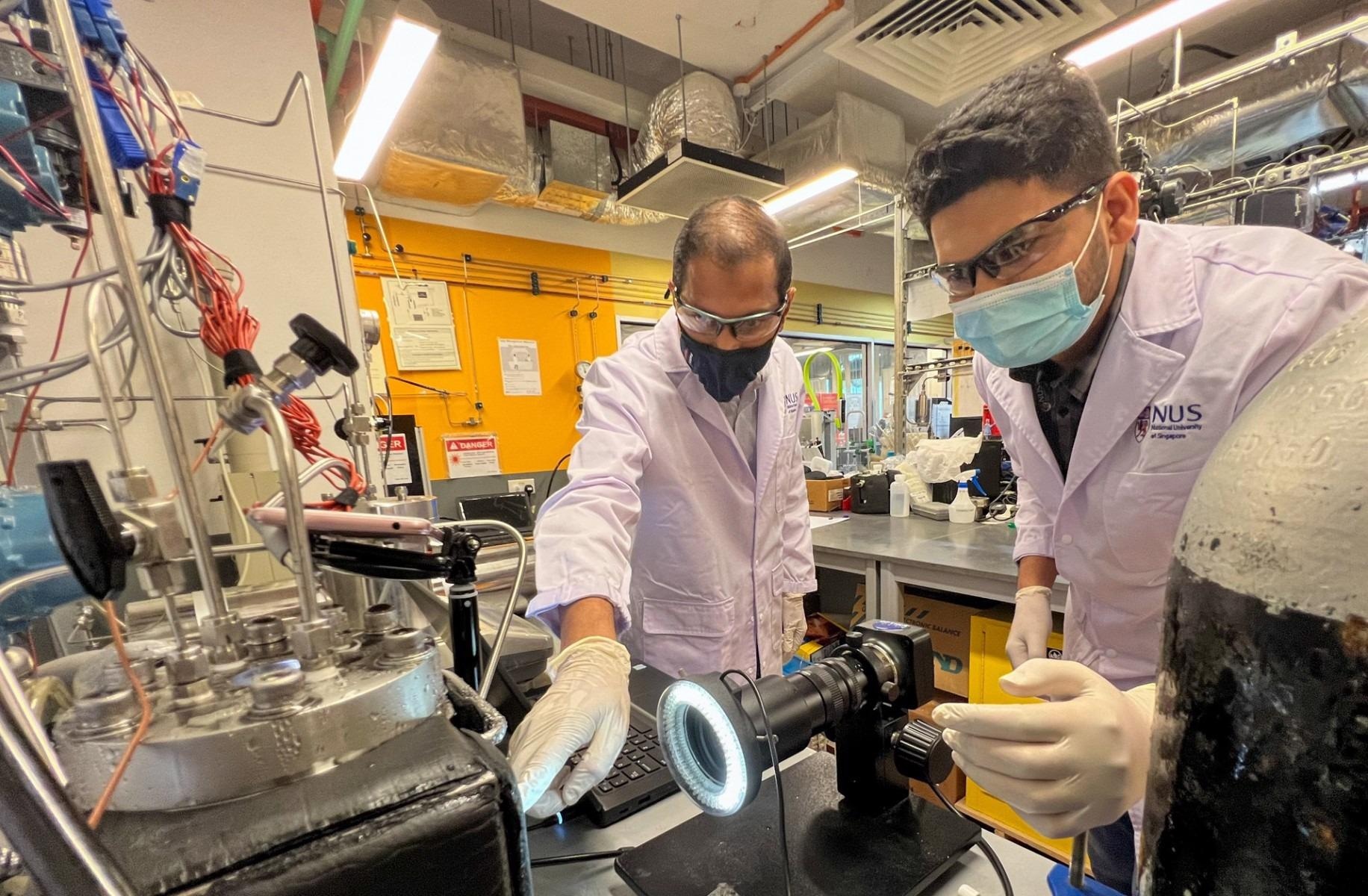Climate change is one of the most unrelenting challenges that humanity is facing. To fight its potentially disastrous effects, researchers are looking for innovative technologies that could help the world realize carbon neutrality.
 Prof Praveen Linga (left) and his team demonstrated the first-ever experimental evidence of the stability of CO2 hydrates in oceanic sediments. Image Credit: National University of Singapore
Prof Praveen Linga (left) and his team demonstrated the first-ever experimental evidence of the stability of CO2 hydrates in oceanic sediments. Image Credit: National University of Singapore
One possible solution that is gaining increasing attention is to trap and store carbon dioxide (CO2) emissions in the form of hydrates under the sediments of the ocean floor, maintained in place by the innate pressure generated by the weight of the seawater above.
A significant question, however, has been how stable this captured CO2 would be for the long periods of storage necessary to ensure that the carbon is kept in place and out of the air.
Recently, scientists from the National University of Singapore (NUS) Department of Chemical and Biomolecular Engineering have shown the first-ever experimental proof of the steadiness of CO2 hydrates in oceanic sediments — a vital step in rendering this carbon storage technology a practical reality.
It's the first of its kind experimental evidence that we hope is going to spur further activity on this technology development.
Praveen Linga, Professor and Study Lead, Department of Chemical and Biomolecular Engineering, National University of Singapore
The team’s results — part of a project financially supported through the Singapore Energy Centre — were first reported in the scientific journal Chemical Engineering Journal.
Using a specially engineered laboratory reactor, the NUS researchers demonstrated that CO2 hydrates can stay stable in oceanic sediments for up to 30 days. Soon, the team says, the same technique can be used to verify the stability of CO2 hydrates for longer periods of time.
Trapped in Ice-Like Substances
At low-temperature and under high-pressure environments formed by the ocean, CO2 can be stored within water molecules, creating an ice-like substance. These CO2 hydrates develop at a temperature just above the freezing point of water and can store nearly 184 m3 of CO2 in 1 m3 of hydrates.
The presence of massive volumes of methane hydrates in similar sites globally and their safe existence offers a natural analogy to support the theory that CO2 hydrates will stay stable and safe if deposited under deep-oceanic sediments.
The researchers state that this technology could ultimately be transformed into a commercial-scale process, allowing nations like Singapore to efficiently sequester over two million tons of CO2 per annum as hydrates to comply with emission reduction targets.
Ocean Floor Conditions
Working with specially engineered equipment, Prof Linga and his team recreated the environments of the deep ocean floor, where temperatures range between 2 °C and 6 °C and pressures are 100 times greater than what is encountered at sea level.
Developing a macro-scale reactor that could sustain such conditions was difficult and is one of the reasons why experiments to verify the stability of CO2 hydrates were not formerly possible.
The NUS researchers surpassed this challenge using an in-house developed pressurized vessel, fitted with a silica sand bed, which mimicked ocean sediments.
The researchers were able to create solid hydrates on top and within the silica sand bed and modified the pressurized vessel to imitate the oceanic environment to view the stability of the formed solid CO2 hydrates in sediments. Under pressurized settings, the hydrates were monitored for 14 to 30 days and were found to exhibit a high level of stability.
This hydrate technology would enable nations to sequester large quantities of carbon emissions in deep-ocean geological formations on top of how it is presently stored in saline aquifer formations and depleted oil and gas reserves.
For nations such as Singapore, which has fixed a target to become carbon neutral by 2050, the technology could be an important tool for decreasing CO2 emissions.
In order to achieve carbon-neutrality targets, we have to look at new options that provide scale and speed to sequester CO2. Deep-ocean sequestration in sediments as CO2 hydrates is a promising solution.
Praveen Linga, Professor and Study Lead, Department of Chemical and Biomolecular Engineering, National University of Singapore
The following step for the team will be to expand the volume and timescale of the experiment.
From an experimental standpoint, we are planning to scale up by 10 times along with further innovations to develop quantifiable tools and methods for the technology.
Praveen Linga, Professor and Study Lead, Department of Chemical and Biomolecular Engineering, National University of Singapore
Going forward, he said, the team is keen to demonstrate a stability of 6 months for the CO2 hydrates.
The team’s latest funding under the Low-Carbon Energy Research Funding Initiative from the Singapore government to create innovative low-carbon energy technology solutions will significantly aid the development of this storage technology.
With the scheduled future experiments, the researchers hope to create and confirm models that can estimate the stability of CO2 hydrates thousands of years into the future.
Journal Reference:
Qureshi, M.F., et al. (2022) Laboratory demonstration of the stability of CO2 hydrates in deep-oceanic sediments. Chemical Engineering Journal. doi.org/10.1016/j.cej.2021.134290.